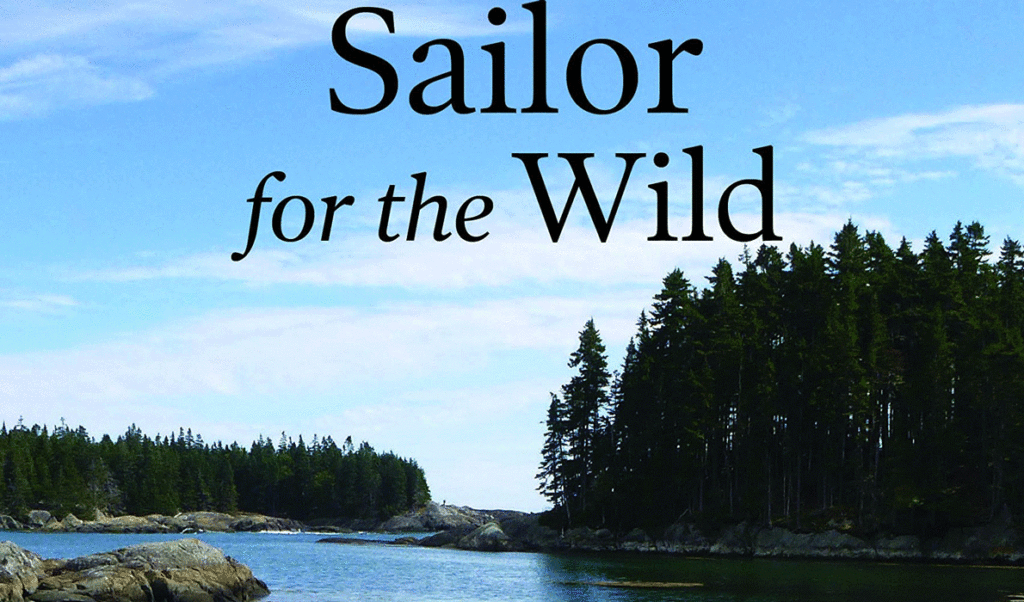Sailor for the Wild: On Maine, Conservation and Boats
By Ben Emory; Seapoint Books, 2017
When Ben Emory completed Navy active duty in 1969—he had served on the destroyer USS New, providing gunfire support along the coast of Vietnam—he took stock of his life. A graduate of Harvard where he majored in American colonial history, Emory had developed a passion for Maine from early visits with his family, his love of the coast enhanced by sailing. He had also become increasingly committed to conservation: “I grew to realize that no place is safe—that overpopulation, human nature and economic need and greed could scar any area.”
By luck Emory was given an opportunity to combine his love of sailing with his new-found environmental idealism. Dr. Charles Foster, founder of the New England Natural Resources Center, proposed a project that would seek to “encourage greater participation by New England yacht clubs in coastal conservation.” Emory put together a prospectus that included visiting the clubs by sail—a way to at once satisfy his hunger to be on the water and make the case for coastal conservation. And he found a sponsor: the American Littoral Society, whose mission was to “empower people to care for the coast through advocacy, conservation, and education.”
Emory stopped at nearly 50 yacht clubs on his trip. The experience provided “excellent experience in the promotion and marketing of conservation ideas,” something that would come in handy when he joined the staff of the fledgling Maine Coast Heritage Trust in 1971. There he would become a master of negotiating conservation easements, a relatively new concept that would prove to be a major focus of land trust work in Maine and across the U.S.
A good part of the book consists of a history of the conservation movement in Maine over the past 50 or so years, and Emory is the perfect narrator. He has been a part of a lot of that history, from his work with MCHT to serving on the Acadia National Park Advisory Commission and the Land for Maine’s Future board. He helped preserve bird-nesting islands downeast, and his testimony before the legislature’s Agriculture, Conservation and Forestry Committee in 2007 helped inspire the creation of the Governor’s Council on Maine’s Quality of Place.
Emory goes out of his way to shine a spotlight on his fellow conservationists.
He offers a roll-call of some of the key players over the years: Peggy Rockefeller and Tom Cabot, who spearheaded the founding of MCHT; Elmer Beal, the trust’s first executive director; Harold Woodsum, who led the MCHT board in the early years; Caroline Pryor, who helped rebuild the Land Trust Exchange; Acadia National Park superintendent Sheridan Steele, a key player in preserving a large portion of the Schoodic Peninsula; Tom Goettel, refuge manager for Petit Manan National Wildlife Refuge; and Philip Conkling, the Island Institute’s visionary founder. Alan Hutchinson, Misha Mytar, Chandler Woodcock, Jeff Romano, Dr. Paul Mayewski—these and other champions are saluted.
Emory also underscores the challenges facing conservation in Maine, from negative PR to “massive failures of political leadership.” He names a few names, but in general couches his criticisms in a gentlemanly manner. He also voices concern over changes in the culture: fewer young people taking up sailing and a diminishment of the appreciation of life outdoors.
Nearly equal time is given to Emory’s love of boats and sailing. There are a number of hair-soaking tales of wicked currents, driving rain, and leeward rails suddenly under water. Sailboat aficionados will enjoy the detailed descriptions of a variety of vessels, from a “Brutal Beast” (a small centerboard catboat) and a catspaw dinghy to a 37-foot yawl named Snowflakedesigned and built by Farnham Butler of Mount Desert Island. A chapter on wooden boats pays homage to Jon Wilson, who has made it his life’s work to preserve this art form.
A passion for place is the overarching theme of this engaging book. Emory’s love of Maine is evident throughout, especially, perhaps, in his paeans to the waters of Eggemoggin Reach, “the home of my soul,” and Meadow Brook Farm in Brooklin, which he and his wife Dianna have stewarded as a bird sanctuary. He tells an important story along the way, inspiring, educational, and enlightening.
Carl Little’s most recent book is Philip Frey: Here and Now(Marshal Wilkes).





